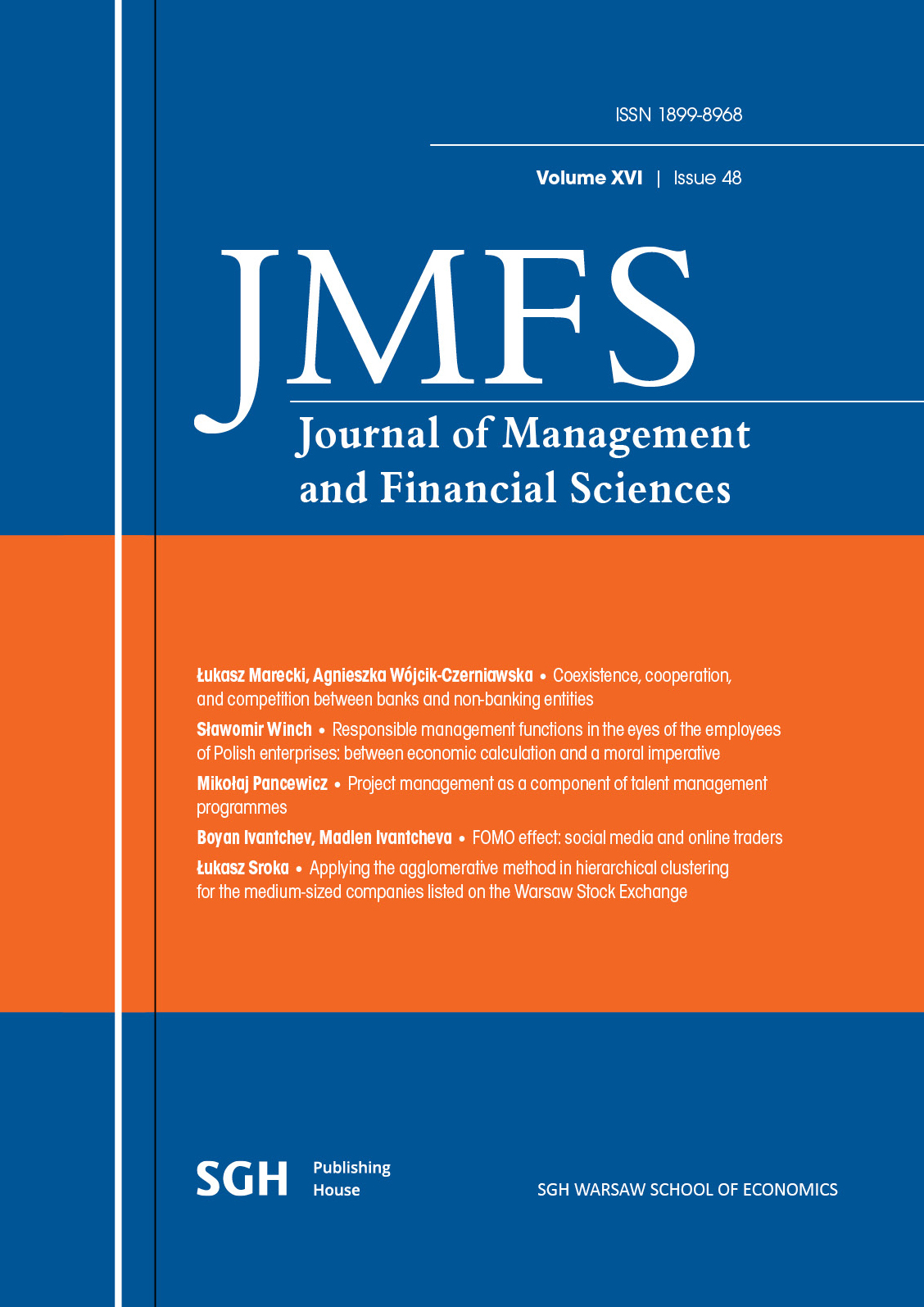Coexistence, cooperation, and competition between banks and non-banking entities
Main Article Content
Abstrakt
Financial stability is essential for the functioning of the economy, and competition between banks is seen as an essential factor for their stability. Reframing the conflict and each party’s goals in such a way that they are mutually dependent increases a party’s chances of reaching an agreement. This study investigates the relationship between bank size and the institution’s stability. Government regulators and anyone else’s ability to keep an eye on the entire financial system is jeopardized when large portions of it are left largely unregulated. Price competition (marginal-cost pricing) reduces the market power of a single firm as the number of firms in an industry grows. Since the 1990s, the banking industry, according to previous studies, has been experiencing concentration and competition. Some argue that the lack of technology in small banks may put them at an advantage in terms of customer satisfaction, but this is not necessarily the case.
Downloads
Article Details

Utwór dostępny jest na licencji Creative Commons Uznanie autorstwa 4.0 Międzynarodowe.
Bibliografia
Articles
Bengtsson, M., Kock, S. (2000). Coopetition in business networks: to cooperate and compete simultaneously. Industrial Marketing Management, 29 (5), pp. 411–426.
Brandenburger, A. M., Nalebuff, B. J. (1995). The right game: use game theory to shape strategy. Harvard Business Review, 7, pp. 57–71.
Bresnahan, T. F. (1982). The Oligopoly Solution Concept Is Identified. Economics Letters, 10, pp. 87–92.
Calem, P., Nakamura, L. (1998). Branch Banking and the Geography of Bank Pricing. The Review of Economics and Statistics, 80, pp. 600–10.
Che, D. {2014). The change of commercial banks coopetition strategy in the Internet financial evolution. International Finance, 2, pp. 7–10.
Čihák, M., Podpiera, R. (2008). Integrated Financial Supervision: Which Model? North American Journal of Economics and Finance, 19, pp. 135–52.
Friedman, D. (1991). Evolutionary games in economics. Econometrica, 59 (3), pp. 637–666.
Friesz, T. L., Mookherjee, R., Rigdon, M. A. (2005). An evolutionary game-theoretic model of network revenue management in oligopolistic competition. Journal of Revenue & Pricing Management, 4 (2), pp. 156–173.
Gomes, O. (2012). Discrete dynamics in evolutionary games. Discrete Dynamics in Nature and Society, Article ID 416789, 23 pages.
Hailong, H. (2013). Research of the internet finance with the core as e-commerce platform. Shanghai Finance, 8, pp. 18–23.
Hannan, T. H. (1991). Bank Commercial Loan Markets and the Role of Market Structure: Evidence from Surveys of Commercial Lending. Journal of Banking and Finance, 15: pp. 133–49.
Hinson, R., Boateng, R., Sorensen, O. J. (2008). E‐business financing: preliminary insights from a developing economy context. Journal of Information, Communication and Ethics in Society, 6 (3), pp. 196–215.
Lanjing, T. (2003). Reflections on the concerted strategy of cooperative enterprises. Theory Monthly, 11, pp. 159–160.
Lau, L. (1982). On Identifying the Degree of Competitiveness from Industry Price and Output Data. Economics Letters, 10, pp. 93–99.
Lin, F., Shaw, M. J., Chuang, M. Y. (2005). A unified framework for managing Web-based services. Information Systems and e-Business Management, 3 (3), pp. 299–322.
Lin, F-R., Po, R-W., Orellan, C. V. C. (2011). Mining purchasing decision rules from service encounter data of retail chain stores. Information Systems and e-Business Management, 9 (2), pp. 193–221.
Melecky, M., Podpiera, A. (2012). Institutional Structures of Financial Sector Supervision, Their Drivers, and Emerging Benchmark Models. MPRA Paper, 37059, University of Munich, Germany.
Miyuan, S., Yi, P. (2000). Stability analysis on strategy alliance. Journal of Industrial Engineering and Engineering Management, 3, pp. 76–78.
Ou, B. (2012). Governance of innovation network in the case of Alibaba. Proceedings of the IEEE International Symposium on Management of Technology (ISMOT ’12), pp. 81–86,
Zhejiang, China.
Perez-Guirao, M. D., Luebben, R., Kaiser, T., Jobmann, K. (2008). Evolutionary game theoretical approach for IR-UWB sensor networks. Proceedings of the IEEE International Conference on Communications Workshops (ICC ‘08), pp. 107–111, IEEE, Beijing, China.
Sun, X. W., Bao, J. L. (2010). Research on the innovation and development of the third-party B2B e-commerce model of China. Proceedings of the 3 rd International Conference on Advanced Computer Theory and Engineering (ICACTE ‘10), pp. V4-317–V4-319, Chengdu, China.
Tao, P. (2013). Credit of small and micro businesses in the age of big data: concurrently the cooperation between bank and e-commerce companies. Times Finance, 5, pp. 232–233.
Xie, P., Zou, C. (2012), Research on internet based finance mode. Journal of Financial Research, 12, pp. 11–22.
Yan, N., Sun, B. (2014). Mode innovation and of network financing for SMEs. Science Technology Progress and Policy, 3, pp. 1–5.
Yang, J., Xu, Z., Zhao, J., Ye, Z. (2010). Comparison and enlightenment among three microcredit models. Shanghai Finance, 9, pp. 81–89.
Yang, R., Shi, P., Liu, G.‑P., Gao, H. (2011). Network-based feedback control for systems with mixed delays based on quantization and dropout compensation. Automatica, 47 (12), pp. 2805–2809.
Yang, Y., Ma, J., Tu, H. (2014). Chaotic characteristics and application of cooperative game and evolutionary game. Discrete Dynamics in Nature and Society, 2014, Article ID 908093, 13 pages.
Zhaoyang, H. (2004). The research of collaborative competition. Journal of Central University of Finance & Economics, 2, pp. 55–57.
Books
Allen, F., Gale, D. (2000). Comparing Financial Systems. Cambridge, MA.: MIT Press.
Brandenburger, A. M., Nalebuff, B. J. (1998). Coopetition. New York, USA: Bantam Doubleday.
Carmichael, J., Pomerleano, M. (2002). The Development and Regulation of Non-bank Financial Institutions. Washington, DC: World Bank.
Mingxiong, T. Y., Yong, L. (2013). Internet Based Finance. Beijing, China: China Financial & Economic Publishing House.
Weibull, J. W. (1995). Evolutionary Game Theory. Cambridge, Mass, USA: MIT Press.
World Bank (2012). Global Financial Development Report 2013: Rethinking the Role of the State in Finance. Washington: World Bank.
